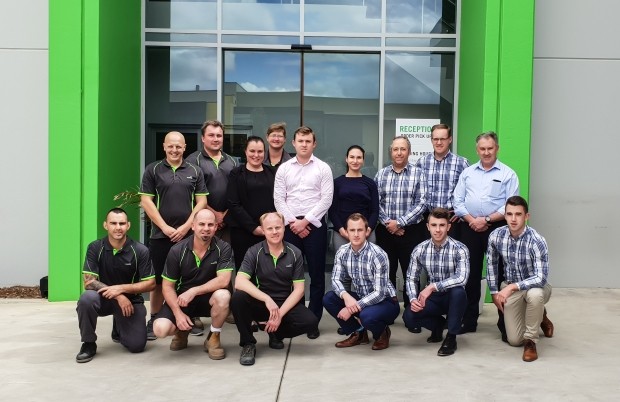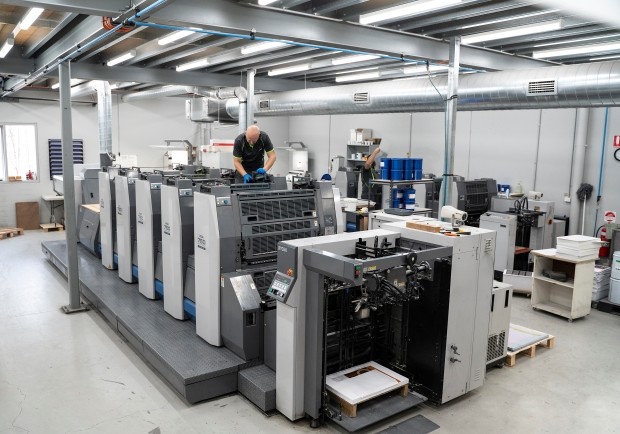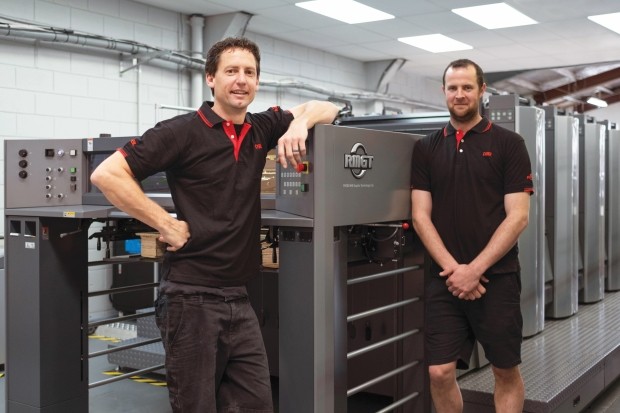
Targeting 20 to 30 per cent revenue boost is the team behind CBS Printing
With two family-owned printers, two countries, and five Ryobi presses between them, CBS Printing, based in Smeaton Grange, NSW, and Kale Print, based in the Bay of Plenty in New Zealand, have recently invested in RMGT 9 series A-1 size presses, purchased through Cyber.
It is the fourth Ryobi press for CBS Printing, and Kale Print’s first. For CBS Printing, the incoming Ryobi 924 LED will triple its print output capacity, while creating efficiencies in its lean 8-up format. For Kale Print, installing the first RMGT 920ST-4 LED-UV press in New Zealand comes with clear wins: instantly dried prints, improving plant performance by eliminating the need for anti-set off spray powder in the manufacturing process.
Both installations offer a window into the advantages of RMGT’s third-generation LED-UV curing, and the applications and markets that open up with the technology: short-turnaround times, better print consistency, and cost efficiencies that come with the low-energy curing. CBS Printing have three Ryobi presses already in their operation, the 754D, 525GX and 522GX-NP presses.
As Nathan Wilson, general manager, CBS Printing explained, “In the past 15 years we have been running Ryobi presses, purchasing our first from Cyber in the mid-2000s. “We have always been able to secure a good deal through Cyber when getting a machine, and every time we go in, their offer has been the pick of the bunch.
“Having everything under the same name gives us other bonuses, whether it is for parts and service, and getting a sense of familiarity across machines, making training simpler.”
At CBS Printing, selecting to invest in a Ryobi press through Cyber is a market-proven move. With the family-run company targeting a 20 to 30 per cent increase in turnover revenue over the next twelve months, bringing jobs in-house is a key part of its plan.
The new press allowing CBS Printing to compete in the 10,000 to 20,000 run size, complementing short-run boutique packaging.
“The big players in the market want orders of 500,000. We want to work with smaller companies, that might package biscuits or meals in smaller volumes, and then help them grow their business through the print and packaging component. By helping them grow, they remain loyal, and a rising tide raises all ships,” Wilson said.
Market experts in LED-UV
Ryobi regards LED-UV as a proven, well-established technology that is making print sites run more efficiently and more environmentally-friendly.
As the pioneers of LED curing, first bringing the technology to its offset presses in 2008, Ryobi has now moved into its latest generation of LED-UV curing system, featuring a long lifetime of 150 million prints.
Now, electrical consumption of the curing units is 6.4kw, barely one tenth of a conventional UV system, with a lifetime that is more than 10 times longer, at 15,000 hours.
With no heat, or ozone, and no exhaust duct, the unit only takes one square metre of space, and does not require a mercury lamp, allowing it to meet environmental considerations. Since 2008, the company has installed more than 500 machines worldwide, while in Japan, over half of its new machines are equipped with LED- UV technology.
The company said LED-UV uses 93 per cent less power than standard UV. While digital print often steals the headlines, RMGT continues working steadily towards its goal of full automation. It classifies levels of automation from zero to four. Zero represents non-automation, where an operator makes all the decisions throughout pre-setting.
It then rises to assistance, on level one, partial automation on level two, an automated driven system on level 2.5, conditional automation at level three, and full automation at level four.

Consistent performer: CBS chooses to boost production with RMGT after steady success
Moving with the times
CBS Printing was founded in 1977 by Geoff Wilson, who was joined by his brother Stephen Wilson in 1986, with each of those brothers then bringing their sons into the business, who are still working there today.
The business now has 18 staff members, operating from a location purchased in 2014, which was double the size of its previous premises.
The next-generation of Wilson leadership has a simple philosophy: working with current marketing trends, and taking a broad-minded outlook on what the industry is doing. “You also need to invest in the latest technology and processes,” Nathan Wilson contended.
CBS Printing uses a combination of Ryobi offset presses and Ricoh digital printers to maximise the effectiveness of their client’s campaigns. This reflects a change in print marketing trends from a ‘pay and spray’ approach, to specialised, personalised, targeted campaigns.
“We have seen a decrease in large, bulk print runs. Now, it is much more important to understand your clients’ business goals, and be able to give input from a campaign/marketing/design/fulfillment perspective.
“The right campaign, targeted to the right people, personalised, gets much better results than bulk unaddressed. An offset machine used with a hybrid approach with digital can allow for that personalisation. This is where our new press will shine. We print the shell of the campaign on our Ryobi press, then use our digital presses to personalise it by name, number, image.”
The instant drying with no spray powder allows for quick movement of the prints from machine to machine.
“For our new press, the concept of LED-UV has been of interest, the benefits of drying time, being able to print on more matte stocks has been key. It is about operating efficiencies, and removing spray powders and conventional things needed on an offset press. It is a change for us; we have not been there before, but have seen others do it. From what we have researched, it will definitely bring productivity to the table,” Wilson said.
Early adopters over the ditch
At Kale Print, which operates out of the Bay of Plenty in New Zealand, the newly-installed 920ST-4 LED is the first RMGT press in the company. While it had previous H-UV presses, experiencing instant drying, the new LED dry-to-dry printing system is offering vibrant colours, and further improved lead times.
The biggest advantage has been in labour, where the new press only needs one operator. With its increased automation, this frees up a second staff member to work on other jobs, presses, and tasks within the business.
As Brent Kale, production manager at Kale Print, explained, “The RMGT purchase completes our commitment to offering a full end to end solution for traditional offset printed products and services for clients, both locally and nationally. Having A1 capabilities, as well as being an independent family business, has meant we have become the first choice in filling the gap for many other printers.
“Some of the other added benefits include much lower power consumption, low heat emissions, less paper set up, and no odour.
“We are now taking a lot of work off the digital machines and doing them offset simply because it is quicker and cost efficient. We are also seeing savings on plates and blanket too.
“Another feature of the RMGT is its capabilities of printing on packaging board, plastics and synthetics with ease, an already growing market for us.
“We have been rapt with the whole experience, working with the expert team from Cyber. “Right from our first site visit in Japan, investigating the machine, through to having the new machine installed into our plant within a few months, everything went smoothly with install.
“We were up and running quickly, producing our first commercial print job within three weeks of the machine arriving in containers.
“With an already existing A2 HUV press, we were already accustomed to the improved plant performance from instant drying. No anti-set off spray powder in the manufacturing process is a real winner.” The RMGT 9 A1-Size offset Ryobi press can reach speeds of up to 16,200 sheets per hour.
The new press comes equipped with a large 55-inch display so operators can easily monitor the jobs being printed and functionality of the press. The PDS-E SpectroDrive is used to measure colour and feedback the correction values to ensure colour matching is maintained during the run.
A Wi-Fi tablet system allows operators to view the machine while working at different areas of the press during production such as the feeder.
Cyber said the RMGT LED-UV system produces no ozone or heat; there is no need to duct the press and, with instant on/off operation and no warm-up of the system required, providing 15,000 hours of diode life and trouble-free operation.
Kale explained, “You don’t require any anti-set off spray powder so you can make even more savings as the press and the environment stays free of the dreaded spray powder. This in turn means less press maintenance and downtime. Of course, wear on the press is significantly reduced.”

Kale ready to print: Michael Elgar (l) with Gavin Kale (r) and the RMGT 920ST-4 LED-UV press
Two different printers, same tangible benefits
CBS Printing and Kale Print are separated by the Tasman, operating in different segments, with a different market share.
While CBS Printing has now installed four Ryobi presses, it is the first toe in the water for Kale Print. CBS is aiming big with its increased capacity – a 30 per cent increase in turnover. Kale Print has a different goal with its installation, to offer a full end to end solution for traditional offset printed products and services for clients, both locally and nationally.
For both the Wilson and Kale families, the RMGT 9 series is an investment which ticks the boxes, opens up applications, and increases efficiencies within the business.
Offset printing has always been a constant pursuit of perfection, a repeatability that customers will pay a premium for. While digital printing gets attention, accolades, and a steady stream of ‘offset-quality’ pronouncements, offset is still the holy-grail when it comes to quality.
The latest technology from forward-thinking manufacturers like Ryobi MHI Graphic Technology (RMGT) considers power-savings, manpower, and flexibility. The A1-size is a winner with a lot of trade operators also, who aggressively target efficiencies to carve out margins in a tight industry.
Comment below to have your say on this story.
If you have a news story or tip-off, get in touch at editorial@sprinter.com.au.
Sign up to the Sprinter newsletter
